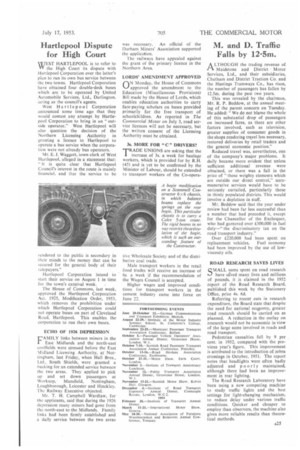M. and D. Traffic Falls by 12.5m.
Page 27

If you've noticed an error in this article please click here to report it so we can fix it.
ALTHOUGH the trading revenue of Maidstone and District • Motor Services, Ltd., and their subsidiaries, Chatham and District Traction Co. and the Hastings Tramways Co., has risen, the number of passengers has fallen by 12.5m. during the past two years.
This was revealed by the chairman, Mr. R. P. Beddow, at the annual meeting of the parent concern on Tuesday. He added: "We do not blame the whole of this substantial drop of passengers on increased fares, as there are other factors involved, such as television, greater supplies of consumer goods in the shops rendering travel less necessary, restored deliveries by retail traders and the general economic position."
Reduced travel was, nevertheless, one of the company's major problems. It daily became more evident that unless sufficient additional revenue were obtained, or there was a fall in the price of "those weighty elements which are outside our direct control," unremunerative services would have to be seriously curtailed, particularly those in thinly populated districts. This would involve a depletion in staff.
Mr. Beddow said that the year under review had been far less successful than a number that had preceded it, except for the Chancellor of the Exchequer, who had garnered over 000,000 in fuel duty—" the discrimin.atory tax on the road transport industry."
Over £220,000 had been spent on replacement vehicles. Fuel economy had been improved by the use of lowviscosity oils.
ROAD RESEARCH SAVES LIVES
SMALL sums spent on road research have si..ved many lives and millions of pounds, it is claimed in the 1952 report of the Road Research Board, published this week by the Stationery Office, price 4s. 6d.
Referring to recent cuts in research expenditure, the Board state that despite the need for national eco,nomy, greater road research should be carried on as planned. A reduction in the outlay on research would not be economic in view of the large sums involved in roads and road transport.
Pedestrian casualties fell by 9 per cent. in 1952, compared with the previous year's figure. This improvement is attributed to the introduction of zebra crossings in October, 1951. The report notes that headlights were often badly adjusted and poorly maintained, although there had been an improvement in rear lighting.
The Road Research Laboratory have been using a new computing machine to study traffic lights and the best settings for light-changing mechanism, to reduce delay under various traffic conditions. Quicker and cheaper to employ than observers, the machine also gives more reliable results than theoretical methods.




















































































